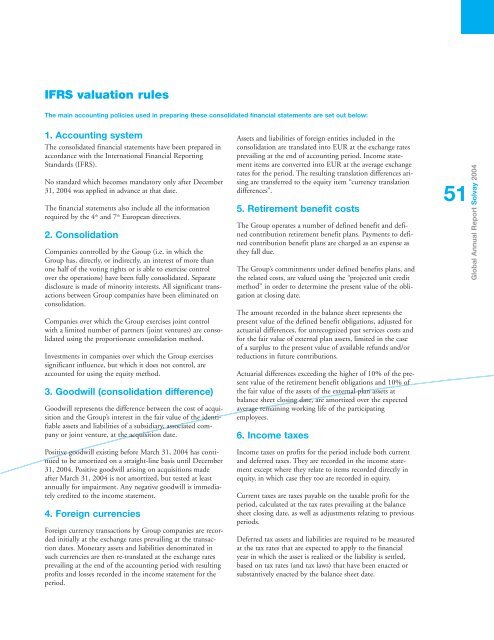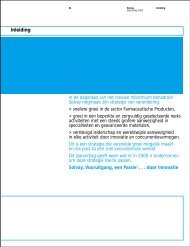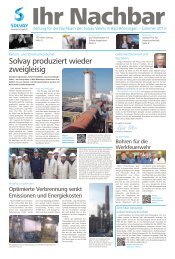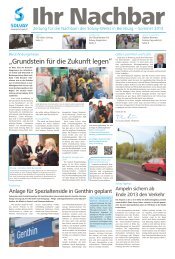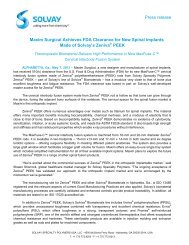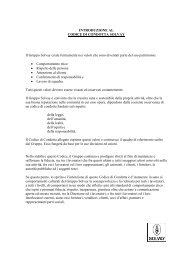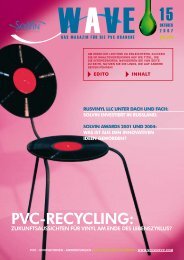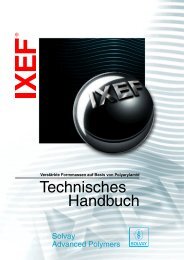Sales breakdown 2004 - Solvay
Sales breakdown 2004 - Solvay
Sales breakdown 2004 - Solvay
Create successful ePaper yourself
Turn your PDF publications into a flip-book with our unique Google optimized e-Paper software.
IFRS valuation rules<br />
The main accounting policies used in preparing these consolidated financial statements are set out below:<br />
1. Accounting system<br />
The consolidated financial statements have been prepared in<br />
accordance with the International Financial Reporting<br />
Standards (IFRS).<br />
No standard which becomes mandatory only after December<br />
31, <strong>2004</strong> was applied in advance at that date.<br />
The financial statements also include all the information<br />
required by the 4 th and 7 th European directives.<br />
2. Consolidation<br />
Companies controlled by the Group (i.e. in which the<br />
Group has, directly, or indirectly, an interest of more than<br />
one half of the voting rights or is able to exercise control<br />
over the operations) have been fully consolidated. Separate<br />
disclosure is made of minority interests. All significant transactions<br />
between Group companies have been eliminated on<br />
consolidation.<br />
Companies over which the Group exercises joint control<br />
with a limited number of partners (joint ventures) are consolidated<br />
using the proportionate consolidation method.<br />
Investments in companies over which the Group exercises<br />
significant influence, but which it does not control, are<br />
accounted for using the equity method.<br />
3. Goodwill (consolidation difference)<br />
Goodwill represents the difference between the cost of acquisition<br />
and the Group’s interest in the fair value of the identifiable<br />
assets and liabilities of a subsidiary, associated company<br />
or joint venture, at the acquisition date.<br />
Positive goodwill existing before March 31, <strong>2004</strong> has continued<br />
to be amortized on a straight-line basis until December<br />
31, <strong>2004</strong>. Positive goodwill arising on acquisitions made<br />
after March 31, <strong>2004</strong> is not amortized, but tested at least<br />
annually for impairment. Any negative goodwill is immediately<br />
credited to the income statement.<br />
4. Foreign currencies<br />
Foreign currency transactions by Group companies are recorded<br />
initially at the exchange rates prevailing at the transaction<br />
dates. Monetary assets and liabilities denominated in<br />
such currencies are then re-translated at the exchange rates<br />
prevailing at the end of the accounting period with resulting<br />
profits and losses recorded in the income statement for the<br />
period.<br />
Assets and liabilities of foreign entities included in the<br />
consolidation are translated into EUR at the exchange rates<br />
prevailing at the end of accounting period. Income statement<br />
items are converted into EUR at the average exchange<br />
rates for the period. The resulting translation differences arising<br />
are transferred to the equity item “currency translation<br />
differences”.<br />
5. Retirement benefit costs<br />
The Group operates a number of defined benefit and defined<br />
contribution retirement benefit plans. Payments to defined<br />
contribution benefit plans are charged as an expense as<br />
they fall due.<br />
The Group’s commitments under defined benefits plans, and<br />
the related costs, are valued using the “projected unit credit<br />
method” in order to determine the present value of the obligation<br />
at closing date.<br />
The amount recorded in the balance sheet represents the<br />
present value of the defined benefit obligations, adjusted for<br />
actuarial differences, for unrecognized past services costs and<br />
for the fair value of external plan assets, limited in the case<br />
of a surplus to the present value of available refunds and/or<br />
reductions in future contributions.<br />
Actuarial differences exceeding the higher of 10% of the present<br />
value of the retirement benefit obligations and 10% of<br />
the fair value of the assets of the external plan assets at<br />
balance sheet closing date, are amortized over the expected<br />
average remaining working life of the participating<br />
employees.<br />
6. Income taxes<br />
Income taxes on profits for the period include both current<br />
and deferred taxes. They are recorded in the income statement<br />
except where they relate to items recorded directly in<br />
equity, in which case they too are recorded in equity.<br />
Current taxes are taxes payable on the taxable profit for the<br />
period, calculated at the tax rates prevailing at the balance<br />
sheet closing date, as well as adjustments relating to previous<br />
periods.<br />
Deferred tax assets and liabilities are required to be measured<br />
at the tax rates that are expected to apply to the financial<br />
year in which the asset is realized or the liability is settled,<br />
based on tax rates (and tax laws) that have been enacted or<br />
substantively enacted by the balance sheet date.<br />
51<br />
Global Annual Report <strong>Solvay</strong> <strong>2004</strong>


